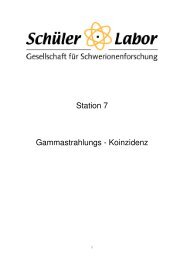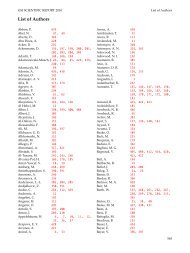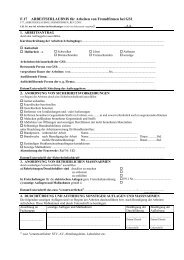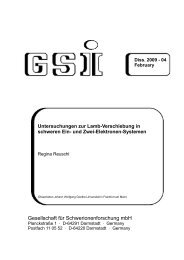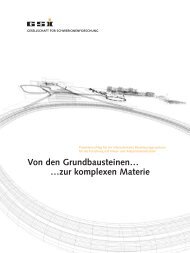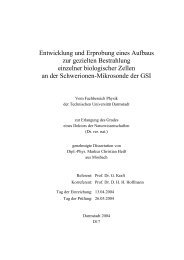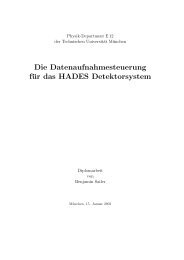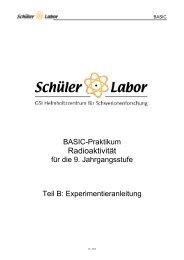CBM Progress Report 2006 - GSI
CBM Progress Report 2006 - GSI
CBM Progress Report 2006 - GSI
Create successful ePaper yourself
Turn your PDF publications into a flip-book with our unique Google optimized e-Paper software.
<strong>CBM</strong> <strong>Progress</strong> <strong>Report</strong> <strong>2006</strong> Overview<br />
<strong>CBM</strong> physics and detector setup<br />
The planned Compressed Baryonic Matter (<strong>CBM</strong>) experiment<br />
at FAIR offers unique possibilities to investigate<br />
baryonic matter at highest densities in the laboratory.<br />
The most promising observables from nucleus-nucleus collisions<br />
in the FAIR energy range are particles containing<br />
charm quarks (D-mesons and charmonium), low-mass<br />
vector mesons decaying into dilepton pairs (ρ, ω and φ<br />
mesons), and hyperons (Λ, Ξ, Ω and their antiparticles).<br />
This includes the measurement of (event-by-event) fluctuations,<br />
correlations, and collective flow of hadrons. A<br />
systematic and comprehensive investigation of these observables,<br />
in particular their excitation functions, will permit<br />
to extract information on the equation-of-state of baryonic<br />
matter at high densities, on the location of the phase<br />
boundary between hadronic and partonic matter (including<br />
the QCD critical endpoint), and on the restoration of chiral<br />
symmetry at high net-baryon densities.<br />
The experimental task is to identify hadrons and leptons<br />
in collisions with up to 1000 charged particles at event rates<br />
of up to 10 MHz. A particular experimental challenge is the<br />
identification of D-mesons which is based on the selection<br />
of secondary vertices with high accuracy. The measurements<br />
require a high-speed data acquisition (DAQ) architecture<br />
and an appropriate high-level event-selection concept.<br />
A schematic view of the proposed <strong>CBM</strong> detector concept<br />
is shown in figure 1. Inside a large aperture dipole magnet<br />
there is a Silicon Tracking and Vertexing System which<br />
consists of two parts: a Micro-Vertex Detector (MVD, 2<br />
silicon pixel layers) and the Silicon Tracking System (STS,<br />
several layers of silicon microstrip detectors). The Silicon<br />
detector array has to provide the capabilities for track reconstruction,<br />
determination of primary and secondary vertices,<br />
and momentum determination. Electrons from lowmass<br />
vector-meson decays will be identified with a Ring<br />
Imaging Cherenkov (RICH) detector. The TRD detector<br />
will provide charged particle tracking and the identification<br />
of high energy electrons and positrons. The ECAL will be<br />
used for the identification of electrons and photons. As an<br />
alternative to the RICH detector a muon detection/hadron<br />
absorber system is under investigation. If the RICH will<br />
be replaced by a muon detector the TRD will be converted<br />
into a tracking detector for hadron measurements together<br />
with the timing RPC. Then the TOF-RPC detector serves<br />
for two purposes: for background suppression during muon<br />
measurements with absorbers, and for hadron identification<br />
with muon absorbers removed.<br />
The <strong>CBM</strong> experiment at FAIR<br />
V. Friese, W.F.J. Müller, P. Senger, <strong>GSI</strong> Darmstadt<br />
1<br />
Figure 1: Schematic view of the Compressed Baryonic Matter<br />
(<strong>CBM</strong>) experiment planned at FAIR. The setup consists of a<br />
high resolution Silicon Tracking System (STS), a Ring Imaging<br />
Cherenkov detector (RICH), three stations of Transition Radiation<br />
Detectors (TRD), a time-of-flight (TOF) system made of Resistive<br />
Plate Chambers (RPC) and an Electromagnetic Calorimeter<br />
(ECAL).<br />
Track reconstruction and STS development<br />
The feasibility studies were performed within the <strong>CBM</strong><br />
software framework which has been developed further. The<br />
routines for track and vertex reconstruction have been improved<br />
and used for optimization of the layout of the Silicon<br />
Tracking System. Track reconstruction efficiencies of<br />
above 95% can be obtained with a fast and radiation-hard<br />
detector system which consists either of two Silicon hybrid<br />
pixel detector stations together with 4 double-sided Silicon<br />
Strip detector layers, or of 6 Strip-sensor layers only.<br />
The STS can be used as a stand-alone tracker for high-rate<br />
measurements and for the identification of hyperons. The<br />
Micro-Vertex Detector (MVD) - which is close to the target<br />
and has limitations in radiation hardness and read-out<br />
speed - will be installed only for open charm measurements<br />
which requires high-precision vertexing.<br />
Detector R&D concentrates on the design of a prototype<br />
STS which includes double-sided sensors, the low-mass<br />
micro-cables, the read-out chip and the mechanical structure.<br />
First prototype sensors have been designed and are<br />
being fabricated. Moreover, a fast self-triggered read-out<br />
chip has been developed within EU FP-6 NMI3 for neutron<br />
applications. It was fabricated and is under tests in<br />
cooperation with <strong>CBM</strong>, where it will serve as a prototype<br />
for the <strong>CBM</strong>-dedicated front-end development and addi-



